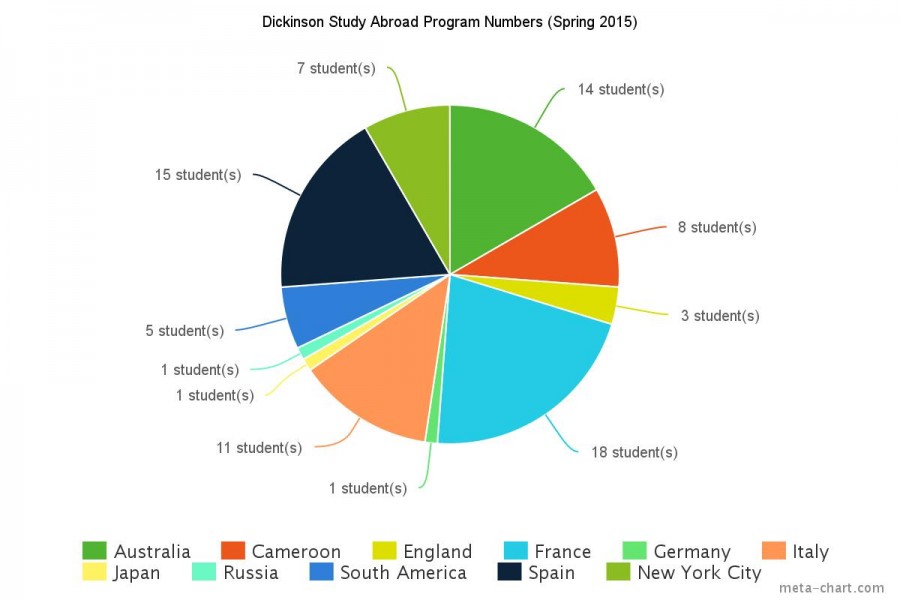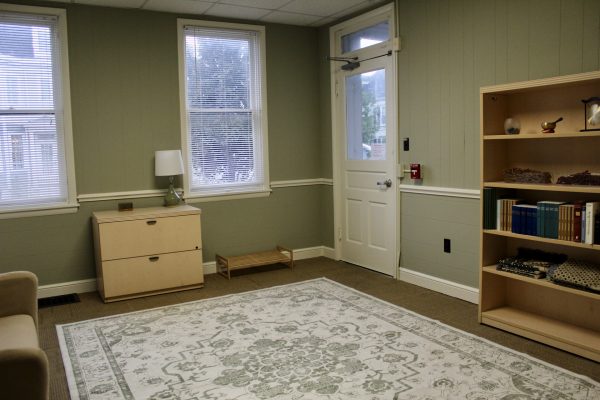Partner Programs Not Detracting from Dickinson Study Abroad Sites
A graph provided by CGSE shows Spring 2015 enrollments at Dickinson-sponsored programs.
Despite a sharp decrease in applications to Dickinson’s study abroad program in Cameroon and a slight increase in enrollment with a partner program in Copenhagen, Denmark, the Center for Global Study and Engagement (CGSE) reports that there has been no noticeable increase in travel to Dickinson partner programs over Dickinson-sponsored programs.
Michael Monahan, associate provost and executive director of CGSE, said that the number of Dickinson students studying abroad this academic year has increased 3.9 percent from the 2014-2015 academic year. The vast majority of these students enroll at one of Dickinson’s 15 established study abroad programs or 19 Dickinson partner programs. Monahan said that while Dickinson-run programs have seen stabe enrollments, “the worrying trends are the programs with very low trends.”
The program that has seen the largest decrease in numbers for the past few semesters of study abroad is the Dickinson in Cameroon program, which is offered exclusively in the spring semester. In the 2014-2015 school year, eight students traveled abroad to Cameroon. For the 2015-2016 school year, however, only two students will participate in the program.
Monahan speculated a possible reason for this trend.
“The news in Cameroon about Boko Haram doesn’t affect our program, but affects the view as whether [Cameroon] is a safe place.”
Trends in popularity of programs change approximately every five to six years, and can be the result of a wide range of factors. In the 1990s and the early 2000s, according to Monahan, Eastern Europe became popular due to the fall of the Berlin Wall. Additionally, travel to developing countries rather than a developed country has also increased.
Monahan showed concern about certain programs becoming weighed down with students while others are not as full.
“Are we too Euro-centric? I think the answer is yes,” Monahan said.
In general, however, the patterns for Dickinson programs are “actually more stable” than a few changing numbers might suggest. For example, the Dickinson in Spain program, based in Malaga, garners approximately 50 students per year over the fall and spring semesters.
“The popularity of [Dickinson in Spain] is no surprise; we’ve been there for 50 years,” said Monahan.
Monahan reports that Dickinson in Australia is consistently popular, as well as the Dickinson partner program with the Danish Institute for Study Abroad (DIS) in Copenhagen, Denmark.
Monahan insists that the growing popularity of particular partner programs does not detract from Dickinson sites abroad.
“There’s a reason we made these partnerships; we want people to go on these programs,” Monahan states. “They’re great programs.”
Monahan said that approximately ten to 15 students choose to study in neither a Dickinson program nor a partner program. In order to do this, a student must make a strong academic case and understand that any financial aid that the student is currently receiving from Dickinson will not carry over as it does with the Dickinson programs or the partner programs.
The process of studying abroad is a “well-worn path,” Monahan said, due to the large amount of interest in going abroad on campus. The process includes an application, recommendations from professors and reviewing by the Global Education Advancement committee, as well as program directors. Once approved, students are generally placed in their first choice location.
Any students with interest in study abroad should schedule an appointment at the CGSE or visit their website for information at http://www.dickinson.edu/global.




